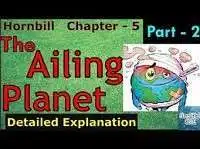
The Ailing Planet: the Green Movement’s Role
By- Nanipalkhivala
Short and Simple Summary of the lesson in English– The Ailing Planet: the Green Movement’s Role/ Summary in simple Words/ Critical appreciation of the lesson – The Ailing Planet: the Green Movement’s Role
Complete Summary
All is not well with our planet, the earth. It is ailing or sick. And all because of our own weaknesses, vices and misdeeds. The earth is facing numerous and big problems. The man has taken all the gifts of Nature for granted. He has been exploiting all the natural resources madly and in excess. He is doing so in the name of development. But the real problem is his selfish motive. He thinks he has absolute right over the land, the sea and what lies deep below in the earth. Overuse of limited resources and their side-effects have made the earth inhabitable, not only for the present generation but also for those who will come hereafter.
In the last 100 years or so, we have done the greatest damage to the earth; we have polluted the air, soil and water. We have created shortages of all things of our basic needs. In 1972, for the first time, the people realised the danger to the very existence of our race, and the urgent need to check it. The Green Movement was started in New Zealand. The panic gripped the imagination of the entire human race. There came a shift in our outlook. We started taking the holistic view of the world, the world as a whole and not in terms of national interests. This change proved revolutionary. For the first time in human history, the people began to see the world as a living organism. As one body, all its needs and parts have to be respected. Preserved and used sensibly. We are, after all, not the absolute masters of this earth. We are only the trustees of this legacy. It is our moral duty not to leave this earth sick and robbed of all natural resources.
In the zoo at Lusaka, Zambia, a notice attracts the visitor, ‘The world’s most dangerous animal’. Inside the cage, there is no animal but only a mirror where you see yourself. In plain words, man is the most dangerous enemy of this planet, his home for thousands of years. The fact is that we are sharing the earth with lakhs of living creatures – big and small. Most of them are nearing their end because we have multiplied dangerously.
The foremost question before us is whether we are going to leave our great grandchildren a planet with advancing deserts and an ailing environment. Our entire economic system is based on four sources—fisheries, forests, grasslands and croplands. These also supply our food and raw materials for our industries. Then below the earth’s surface lie deposits of minerals and crude oil. In most parts of the world, we have exploited these systems to a point that they are almost collapsing. The fishes are fast disappearing in rivers and the sea. The forests are disappearing. The grasslands are turning into wastelands. The agriculture is on its last legs. Many species of life are facing extinction as a result of the destruction of forests for more space and to meet the need for fire-wood. As forests grow smaller, the deserts overtake. People use cow dung not as a natural fertiliser but for burning to cook food.
We, today, are losing almost two acres of forests per second. Our constitution provides that the state shall protect the environment, the forests and the wildlife. But laws are never respected, nor enforced in India. It is in line with the laws to end untouchability, bonded labour and casteism.
A study conducted by the UN warns that the environment is a critical stage in 88 countries investigated. What, after all, are the factors marring the future of human society? On top of all the evils, is population growth. Every four days, the world population increases by ten lakh people. In 1800, the total world population was 100 crores. By 1900, the number rose to 200 crores. But by the end of 2000, the population is touching 600 crores. The only way to check the numbers is all-round development—widespread education and better income. But all development comes to zero with the increase in population. As the rich get richer, the poor produce more children and remain poor. Should menfolk be sterilised like cattle? The better way is voluntary family planning. Population control must get topmost priority if we want to survive.
We need to protect our environment from pollution. It is our only passport for the future. Industry can play a crucial role in keeping our air, water and soil clean. No generation has a freehold on this earth. We have got only life tenancy. We have not inherited it from our forefathers; we have borrowed it from our children.
The Ailing Planet: the Green Movement’s Role- Introduction
The Ailing Planet: the Green Movement’s Role- Important Word-Meanings of difficult words
The Ailing Planet: the Green Movement’s Role- Summary in Hindi – Full Text
The Ailing Planet: the Green Movement’s Role- Important Extra Questions Short Answer Type
The Ailing Planet: the Green Movement’s Role- Important Extra Questions Long Answer Type
The Ailing Planet: the Green Movement’s Role- Important Extra Questions Value-Based Answer Type